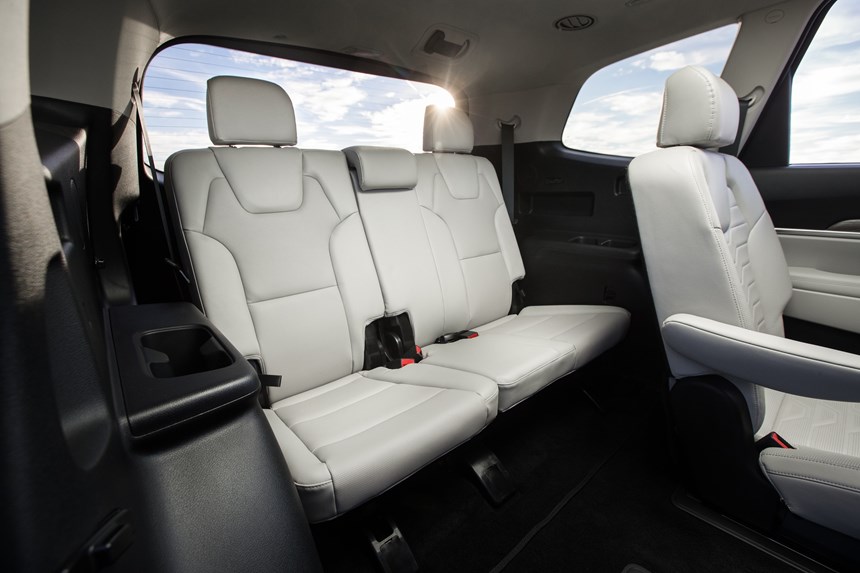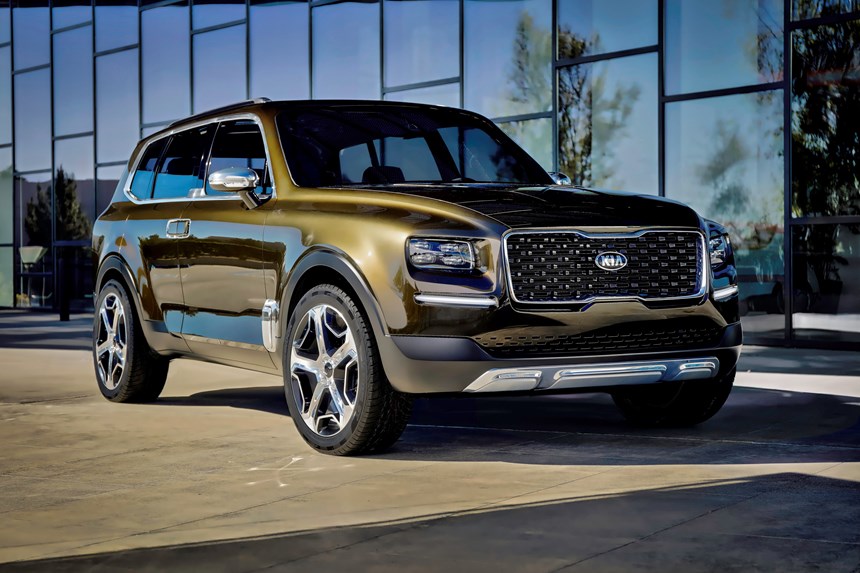The Telluride Arrives
Big, bold and boxy—Kia is building a midsize crossover in Georgia that combines style with technology.
#interior
Think about it: in the midsize crossover class there are a lot of vehicles. Including the Honda Pilot. The Toyota Highlander and 4Runner. The Ford Explorer. GM has the Chevy Traverse, GMC Acadia and Buick Enclave. Volkswagen chose the category for its big push back into the graces of U.S. customers with the Atlas.
But where was Kia? It has the Sorento and Sportage. But nothing big. The company unveiled at the 2016 North American International Auto Show in Detroit a three-row luxury SUV named “Telluride.” At the time, Tom Kearns, chief designer, Kia Design Center America (KDCA), said, “Longer, wider and taller than the recently redesigned Sorento CUV, Telluride allows us to envision what a full-size seven-passenger SUV from Kia could look like.”
That “could” in his statement was a bit of a fudge because they were working on the real vehicle that would carry the same name. They benchmarked the Highlander and the Pilot. And the design team at KDCA in Irvine, CA, went at it, developing something that would have the distinctiveness that Kia models are known for, from the Soul to the Stinger.
And Kurt Kahl, the lead exterior designer, came up with a design that is “boxy on purpose,” predicated on the idea that nowadays, crossovers have been styled with more smooth radii than sharp creases. They wanted something that looks solid. Strong. Muscular. A broad, long hood. A windshield far more upright than is what is now the norm. A sculpted rear skid-plate with twin exhaust tips, side-to-side on the right side of the vehicle.
Arguably, they are taking a risk with this design approach. When the current Pilot (third generation) came out, it has a more aero design than its boxy predecessor because the feedback that Honda received from customers that they thought the second-generation vehicle, because of its boxiness, was fuel inefficient.
Perhaps the run of low gas prices has made consumers somewhat indifferent to miles-per-gallon ratings, although the Telluride is no slouch in this category: the vehicles—available as a front-wheel drive (FWD) setup or with a active on-demand all-wheel drive (AWD) system (which is based on an electro-hydraulic coupling that activates the multiplate clutch as needed; during normal driving the power is 100 percent to the front wheels but torque is distributed to the rear wheels should slippage be detected, and there are selectable modes, such as “Snow, which has an 80/20 front to rear split and Sport, which provides 65/35)—are all equipped with an Atkinson cycle 3.8-liter V6 producing 291 hp at 6,000 rpm and 262 lb-ft of torque at 5,200 rpm mated to an eight-speed automatic. FWD vehicles have an estimated 20/26/23 mpg city/highway/combined, while the AWD models return an estimated 19/24/21 mpg, which is certainly reasonable for a vehicle that can accommodate eight people and which has a curb weight ranging from 4,112 pounds to 4,482 pounds, depending on trim and packaging. (Arguably the vehicle would be heavier were not that the body structure is made with 59.4 percent advanced high-strength steel.)
Speaking of packaging, this is where the vehicle has garnered a considerable amount of attention by the design and engineering teams. When Kearns introduced the concept he described it as “a luxury SUV with an abundance of advanced technology,” and the concept has morphed into the production vehicle with little straying from that point, as, for example, the seats are covered with either leatherette (SOFINO material), leather or Nappa leather; the steering wheels across all four trim levels are wrapped with leather. With the exception of the base model (the LX) the other three have power adjustable driver seats, with the S and EX offering 8-way adjustability and the SX 10-way (and that seat also offers a seat bottom extension and thigh support). In many cases, the third row of vehicles tends to be something of a penalty box, the seats in the back of the Telluride actually recline. While the metal and wood trim surfaces are actually artificial, the overall fidelity to the real things is first-rate. As this is a vehicle that may actually be used to haul things, there are remote seat folding buttons in the cargo area; the maximum cargo capacity (i.e., second and third rows folded) is 87-ft3 (the total interior volume is 178.1-ft3).
Then there is the technology mentioned. All trims have a telematics mobile unit, a.k.a., embedded modem. There is either an 8-inch audio display unit in the instrument panel or a 10.25-inch TFT navigation display unit. Both offer Android Auto, Apple CarPlay SIRIUS, and offer Bluetooth with voice recognition.
Then there is the acronymic technologies, including the standard downhill brake control (DBC), hill-start assist control (HAC), trailer stability assist (TSA—there is 5,000-pounds of towing capacity), torque vectoring corner control (TVCC), vehicle stability management (VSM), blind spot collision-avoidance assist rear (BCA-R), forward collision avoidance with pedestrian detection (FCA), lane departure warming (LDW), lane following assist (LFA), lane keeping assist (LKA), parking distance warning-reverse (PDW-R), rear cross-traffic collision-avoidance assist (RCCA), rear view monitor (RVM) with parking guidance-dynamic, and smart cruise control (SCC) with stop and go (S&G). These are all standard—yes, even on the FWD Telluride LX that has a starting MSRP of $31,690. Product planners at other OEMs are going to have to do some recalculations in light of this.
The Telluride not only has the name of an American town, but the vehicle is produced in an American factory, at the Kia Motors Manufacturing Georgia (KMMG) facility in West Point. The KMMG plant is the only automotive assembly facility in the state. KMMG, a $1.1-billion operation, launched in November 2009, producing the Sorento mid-size crossover. Two years later, the Optima sedan was added to the mix. Then almost 10 years after the plant started production, the Telluride was introduced to the factory. The plant, running three shifts, has an annual capacity of 340,000 vehicles.
While sedan sales are down across the industry, with the buoyancy of the crossover categories, odds are Kia Motors America is going to need that capacity.
RELATED CONTENT
-
About the 2019 Toyota RAV4
Last year Buick sold 219,231 vehicles in the U.S.
-
2019 Chevrolet Blazer Premier AWD
The 2019 Chevy Blazer is the most-complete Chevy I’ve ever driven, as in seemingly every detail of the crossover having been carefully considered and appropriately executed, from the front end that has a design the likes of which is absolutely rare in a category of vehicles that is getting more undifferentiated by the moment to even consideration given to the piping on the IP.
-
The Genovation GXE: >220 mph and Street Legal
A 2019 Corvette Grand Sport has a starting price on the order of $66,950. The Genovation GXE, which is predicated on the Corvette Grand Sport, will set you back some $750,000.


.jpg;width=70;height=70;mode=crop)


